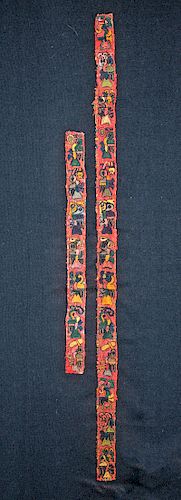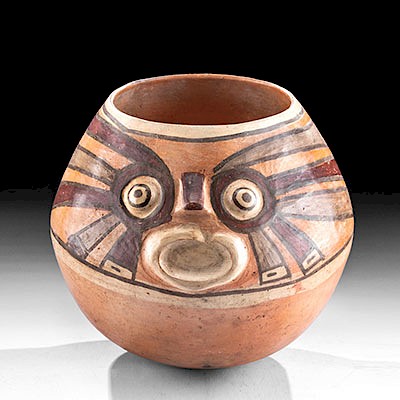Rare Paracas Textile Borders w/ Hummingbirds (2)
Lot 101
About Seller
Artemis Fine Arts
686 S Taylor Ave, Ste 106
Louisville, CO 80027
United States
Selling antiquities, ancient and ethnographic art online since 1993, Artemis Gallery specializes in Classical Antiquities (Egyptian, Greek, Roman, Near Eastern), Asian, Pre-Columbian, African / Tribal / Oceanographic art. Our extensive inventory includes pottery, stone, metal, wood, glass and textil...Read more
Estimate:
$3,500 - $5,000
Absentee vs Live bid
Two ways to bid:
- Leave a max absentee bid and the platform will bid on your behalf up to your maximum bid during the live auction.
- Bid live during the auction and your bids will be submitted real-time to the auctioneer.
Bid Increments
| Price | Bid Increment |
|---|---|
| $0 | $25 |
| $300 | $50 |
| $1,000 | $100 |
| $2,000 | $250 |
| $5,000 | $500 |
| $10,000 | $1,000 |
| $20,000 | $2,500 |
| $50,000 | $5,000 |
| $100,000 | $10,000 |
| $200,000 | $20,000 |
About Auction
By Artemis Fine Arts
Dec 5, 2019
Set Reminder
2019-12-05 10:00:00
2019-12-05 10:00:00
America/New_York
Bidsquare
Bidsquare : Ancient / Ethnographic - Holiday Edition
https://www.bidsquare.com/auctions/artemis-gallery/ancient-ethnographic---holiday-edition-4710
What to give this holiday season? Ancient & Ethnographic Art of course! Our special Holiday auction features hundreds of unique finds from all over the world. Artemis Fine Arts info@artemisfinearts.com
What to give this holiday season? Ancient & Ethnographic Art of course! Our special Holiday auction features hundreds of unique finds from all over the world. Artemis Fine Arts info@artemisfinearts.com
- Lot Description
Pre-Columbian, South Coast Peru, Cavernas, Paracas culture, ca. 500 to 300 BCE. A fabulous example of two slender textile borders composed of tightly woven camelid (alpaca or llama wool) fibers in vibrant hues of crimson, tangerine, emerald-green, fuchsia, cobalt-blue, sage, grey, and black. Both border panels have a red-hued ground atop which registers of abstract hummingbirds are featured. Each petite hummingbird has a triangular tail, feathery wings folded back as if in flight, ovoid heads, and narrow beaks holding either serpentine or phytomorphic forms. Mounted atop a museum-quality display fabric. Size of largest (textile): 27.375" L x 1.125" W (69.5 cm x 2.9 cm); (display fabric): 40.25" L x 15.5" W (102.2 cm x 39.4 cm).
From the Paracas period to the proto-Nazca, artwork was dominated by representations of avian forms - often including hummingbirds. Peru is home to 127 different known species of hummingbirds. What people during this time period thought of the animals is not clear - in Mesoamerica, they were associated with war and seen as ferocious, while in the Amazon they were associated with medicine because of their long, probing beaks being similar to the process by which "spirit darts" were taken from the sick and wounded.
Provenance: ex-private Hans Juergen Westermann collection, Germany, collected in 1950 to the 1960s
All items legal to buy/sell under U.S. Statute covering cultural patrimony Code 2600, CHAPTER 14, and are guaranteed to be as described or your money back.
A Certificate of Authenticity will accompany all winning bids.
We ship worldwide and handle all shipping in-house for your convenience.
#150522Both items are sections of larger border panels. Each item has light staining and fading to original pigmentation, and minor fraying to some interior and peripheral fibers. Iconography still visible and clear.Condition
- Shipping Info
-
All shipping is handled in-house for your convenience. Your invoice from Artemis Gallery will include shipping calculation instructions. If in doubt, please inquire BEFORE bidding for estimated shipping costs for individual items.
-
- Buyer's Premium



 EUR
EUR CAD
CAD AUD
AUD GBP
GBP MXN
MXN HKD
HKD CNY
CNY MYR
MYR SEK
SEK SGD
SGD CHF
CHF THB
THB













